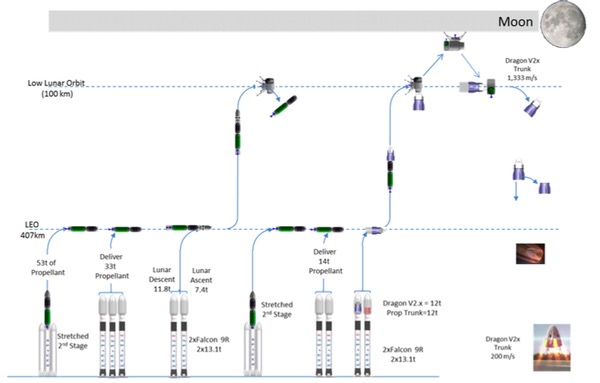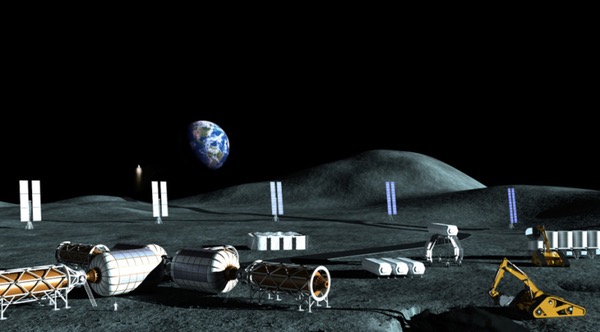Cutting the costs of a human return to the Moonby Jeff Foust
|
| “We basically say in this study that, in a step-by-step incremental fashion, leveraging commercial partnerships, you can return to the Moon,” said Miller. |
If government space agencies aren’t in a huge rush to get humans back to the Moon, the private sector is not making much progress on its own, either. Golden Spike made a big splash with its lunar mission plans in 2012, but has offered little evidence of recent progress towards those goals. Ventures planning robotic missions—far less technically and financially challenging than human ones—have also struggled, as shown by the slipping deadlines of the Google Lunar X PRIZE.
If governments aren’t eager to return to the Moon, and if companies don’t have the resources to go on their own, could the two work together? That’s the proposal advanced in a NASA-funded report released last week, which argued that public-private partnerships, modeled on the agency’s commercial cargo and crew programs, could get humans back to the Moon faster and less expensively than either a pure government or commercial approach.
“We basically say in this study that, in a step-by-step incremental fashion, leveraging commercial partnerships, you can return to the Moon. It’s technically feasible,” said Charles Miller at a press conference in Washington on the 46th anniversary of the Apollo 11 landing.
Miller, president of consulting company NexGen Space LLC and a former senior advisor for commercial space at NASA, was the principal investigator for the study titled “Economic Assessment and Systems Analysis of an Evolvable Lunar Architecture that Leverages Commercial Space Capabilities and Public-Private-Partnerships.” That study was supported by a $100,000 contract from the Emerging Space Office in NASA’s Office of the Chief Technologist.
Not only is this approach technically feasible, it’s relatively affordable and expedient. Miller said the study found that the initial phase could be carried out with two providers—preserving competition, as in the commercial cargo and crew programs—for $10 billion, landing humans on the surface of the Moon for short-term “sortie” missions within five to seven years.
Those sortie missions, to the equatorial regions of the Moon, would be part of the first phase of a three-stage architecture. That first stage would also include robotic missions to the lunar poles to prospect for water ice, which will play a major role in the later phases of the program.
A reason for the relatively low cost and high speed of the concept is that it would leverage launch vehicles and spacecraft that either exist today or are under active development. The study examined in detail one specific approach making use of SpaceX’s Falcon Heavy and Falcon 9 launch vehicles, and its Dragon crew spacecraft. The major new element was a lunar lander, although the study assumed modifications to the Falcon Heavy’s upper stage and trunk section of the Dragon to accommodate additional propellant. Even the new lander would make use of SpaceX’s SuperDraco thrusters it is developing for the escape system of its Dragon spacecraft.
| “Our group, looking at the economic viability of the plan, found absolutely no showstoppers,” said Davidson, a member of the independent review team. |
The SpaceX-specific architecture is not the only way to sending humans back to the Moon, the report notes. It suggests that an alternative approach could make use of United Launch Alliance’s upcoming Vulcan launch vehicle, coupled with a new upper stage planned for it and Boeing’s CST-100 crew spacecraft (along with, again, a new lunar lander.) The approach wasn’t studied in detail, in part because ULA didn’t unveil the Vulcan until April, but the report argues it could have some technical advantages given the Vulcan’s liquid-oxygen/liquid-hydrogen upper stage. “This new capability is projected to be price competitive with SpaceX,” the report concludes.
 An illustration from the report describing one mission architecture for taking people to the Moon in phase one of the overall plan, making use here largely of SpaceX-developed launch vehicles and spacecraft. |
That approach would be carried out under a public-private partnership in that initial phase, modeled after the commercial cargo and crew programs and making use of funded Space Act Agreements. Those companies would be free to use that same architecture for non-NASA missions, such as for countries or even individuals seeking their own human mission. Miller said a ticket price would, at this phase, cost an estimated $600–700 million per person.
While the human lunar return is a key element of this initial phase, finding suitable deposits of water ice at the poles is just as important. “We don’t know exactly how much water there is on the Moon or how deep it is,” he said. “That is a key issue that we need issue to understand. If there’s one thing we should do soon, that is to send a resource prospector to the Moon.”
Returning humans to the Moon, though, is only the first step of the effort outlined in the report, assuming water ice resources are accessible. In the second phase, humans would carry out sortie missions to the most promising sites at the lunar poles identified by the robotic precursor missions in the first phase. The goal of this phase is to create a pilot plant to convert water ice into liquid hydrogen and liquid oxygen propellants.
The third phase would transition from sortie missions to a four-person permanent base, whose crew would oversee development and operations of a propellant production plant. That plant would produce at least 200 metric tons of propellant per year that is transported to a depot at the Earth-Moon L2 point. From there, the propellant could be sold to NASA for use in deep space exploration missions: Miller said that with the lunar-produced propellant, the number of Space Launch System missions needed for a human Mars expedition could drop from twelve to three, since propellant would not need to be launched from the Earth.
“NASA, as a customer for propellant, could substantially pay or, potentially, even 100-percent pay for the operation of the lunar base,” Miller said. Alternatively, the propellant could be sold to commercial entities, who might also purchase seats to the lunar surface at about one-fourth the cost of phase one mission given the use of reusable landers fueled by lunar-produced propellant.
Phases two and three would also shift from the model of public-private partnerships used on the commercial cargo and crew programs to what it calls an “International Lunar Authority” that would better handle some of the technical, financial, and programmatic risks of public-private partnerships. That authority, the report argues, could be patterned after CERN or port authorities.
“In general, authorities have proven to be very successful at developing resources, for building infrastructure, and then managing complex infrastructure operations after development is complete,” the report states. “Authorities blend the powers of government with the economic efficiency of private industry, while managing hugely complex high-tech industries where the safety of the public is involved.”
The total cost of this approach, from the beginning of phase one through the establishment of the permanent base in phase three, likely no earlier than the mid-2030s, costs an estimated $40 billion (that figure, like the earlier cost estimate for phase one, has an uncertainty of about 30 percent.) That, Miller said, could fit within the current NASA human space exploration budget of $2.8 billion a year.
Given the scope and budget of the study, it did not go into great detail about the technical and financial issues associated with this concept. However, Miller and his study group did have an independent review team examine their effort. The 21-person team, chaired by former NASA official Joe Rothenberg, found no major problems with the concept of this “evolvable lunar architecture.”
One of those independent reviewers was Chris Kraft, the famous Apollo-era flight controller and former director of NASA’s Johnson Space Center. “I think it’s a very good one,” he said of the study in a pre-recorded video shown at the press conference.
| “The thing that is absolutely necessary: there has to be a will to do it,” said Moser. “If there is not a will, it will not happen.” |
He emphasized the importance of international collaboration, though a mechanism like an international lunar authority, in his comments. He was a little skeptical, though, of the plan of returning humans to the Moon within seven years of formal go-ahead. “I think that’s very optimistic,” he said, “but that’s not a bad thing at this point in time.”
Hoyt Davidson, managing partner at Near Earth LLC and another member of the independent review team, saw no issues from the financial side of the plan. “Our group, looking at the economic viability of the plan, found absolutely no showstoppers,” he said. “There are certainly more things that need to be studied, more issues that need to be addressed, but, bottom line, we saw this as a very doable business plan.”
Just when, and how, those issues will be addressed is uncertain. While Miller said NASA was a “tremendous supporter” of the study, a human return to the Moon, even as a public-private partnership, is not a part of current human spaceflight policy in the US.
“It’s the elected leaders of our nation who decide what’s next,” he said. “If the White House and Congress would like NASA to look at taking the next step, I think NASA would be quite responsive.”
A key message of the study, he said, was intended for the general public: human return to the Moon need not be as expensive as Apollo, or more recent government-led proposals. “One of the key messages here is that we want to kill the idea that it has to cost hundreds of billions of dollars to go back to the Moon,” Miller said. “That ides should die a quick death.”
Reducing the cost of returning humans to the Moon is certainly one barrier, but it’s not clear if alone is sufficient for such an initiative to go forward. “The thing that is absolutely necessary: there has to be a will to do it,” Tom Moser, a former NASA official who served on the independent review team, said at the press conference. “If there is not a will, it will not happen.”
